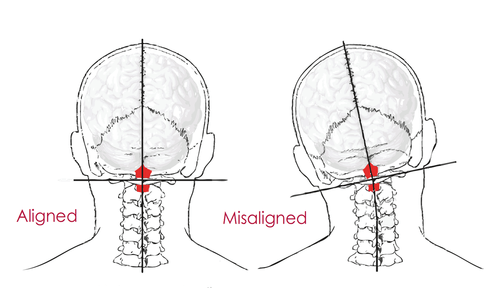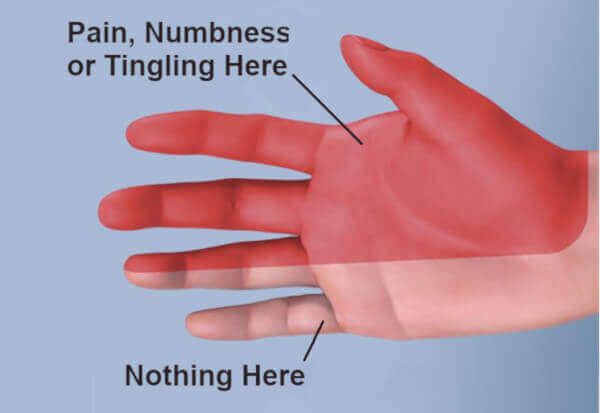Spine Misalignment & Carpal Tunnel: How They're Connected
Table of Contents
- What is carpal tunnel syndrome?
- What is spine misalignment?
- How spine misalignment can trigger or mimic carpal tunnel
- How to tell the difference between spine misalignment & carpal tunnel
- Tip to screen yourself
- Summary
- FAQs
- About
Spine misalignment can sometimes mimic or contribute to carpal tunnel symptoms. When the cervical vertebrae in the neck are out of alignment, the nerves that travel from the spine to the hand can become compressed (a condition called cervical radiculopathy). This can cause numbness, tingling, or weakness in the hand—similar to carpal tunnel syndrome, which occurs when the median nerve is compressed at the wrist.
Usually carpal tunnel symptoms affect both hands, while
spine-related symptoms are more likely to affect one side. Understanding where the nerve is being compressed can help you choose the right treatment.
Many people are surprised to learn that hand numbness, tingling, or weakness isn’t always caused by carpal tunnel syndrome. In some cases, these exact symptoms can actually stem from your spine—specifically, when the cervical vertebrae in your neck are out of alignment. Because the symptoms of
spine misalignment and carpal tunnel can overlap, the two conditions are often confused, which can lead to delayed or incorrect treatment.
Understanding
where the problem is coming from is the key to getting real relief. Below, we break down what’s happening in each condition, how the symptoms compare, and how to tell them apart.
What is carpal tunnel syndrome?
Carpal tunnel syndrome occurs when the
median nerve
(the nerve responsible for sensation and movement in most fingers) becomes
compressed inside the wrist. This nerve passes through a narrow space called the carpal tunnel along with several tendons.
When tissues (particularly the
flexor tendons)
inside the wrist become inflamed or swollen, they can press against the median nerve, causing:
- Pain in the hand or wrist
- Numbness or tingling (especially in the thumb, index, middle, and half of the ring finger)
- Burning or pins-and-needles sensations
- Electric shock-like sensations
- Weakness or dropping objects
Symptoms often
start at night, and in about
80% of cases,
both hands are affected. Carpal tunnel is also much
more common in women than men.
Carpal tunnel doesn’t suddenly appear—it develops when the wrist is stressed repeatedly over time, especially with gripping or repetitive hand movements.
What is spine misalignment?
Your spine is made of stacked vertebrae that protect your spinal cord and support posture and movement. When the spine becomes
misaligned, especially in the neck (cervical spine), the nerves that travel from your spinal cord down to your hands can become irritated or compressed.
This condition may cause:
- Neck or shoulder pain
- Headaches or fatigue
- Tingling or
numbness in one hand or arm
- Loss of grip strength
- Reduced mobility
In particular,
cervical radiculopathy occurs when pressure on a nerve root in the neck causes symptoms along that nerve’s pathway—often felt in the hand.
How spine misalignment can trigger or mimic carpal tunnel
There are two main ways spine misalignment can influence the wrist and hand:
1. Nerve Compression (Cervical Radiculopathy)
Misalignment in the neck can directly
compress nerves that travel to the hand. This can cause numbness or tingling
even if the wrist is completely healthy.
2. Altered Body Mechanics
When the spine is misaligned, muscles must work unevenly to compensate. Over time, these imbalanced forces can place extra strain on the wrist and hand—possibly
triggering or worsening carpal tunnel syndrome if you're already prone to it.
>> So, spine misalignment can
mimic carpal tunnel symptoms—or even
contribute to developing it.
How to tell the difference between spine misalignment & carpal tunnel
Because both conditions can cause numbness, tingling, or weakness in the hand, it’s important to look closely at
where
the symptoms begin and
how
they change with movement.
Carpal Tunnel Syndrome usually affects the
thumb, index finger, middle finger, and half of the ring finger.
The pinky finger is rarely involved. Symptoms often
worsen at night or when the wrist is bent. And in most cases (about 80% of the time),
both hands are affected.
Spine misalignment, especially in the neck, tends to cause symptoms that
start higher—in the neck, shoulder, or arm—before appearing in the hand. These symptoms often
change when you move your head or neck, and they usually affect only
one side of the body.
A simple way to think of it:
- If moving the
wrist
makes symptoms worse
→ Carpal Tunnel
is more likely.
- If moving the
neck
changes the symptoms
→ Spine Misalignment may be involved.
To confirm carpal tunnel specifically, doctors (and even you at home) can perform
provocative tests
such as
Phalen’s, Tinel’s,
or
Durkan’s,
which temporarily stress the median nerve to see if symptoms are triggered.
You can also perform these tests on yourself to determine if you have carpal tunnel.
Tip to screen yourself
Summary
Spine misalignment and carpal tunnel syndrome can cause nearly identical symptoms—but they originate in two different areas of the body. In some cases, spine misalignment can even contribute to or trigger carpal tunnel symptoms. Understanding the source of your pain or numbness helps ensure you choose the right treatment and avoid unnecessary procedures.
FAQs
1. Can spine problems really cause hand numbness?
Yes. Nerves that control your arms and hands originate in your cervical spine. When these nerves are compressed or irritated, you may feel numbness, tingling, or weakness in the hand—even if the wrist itself is healthy.
2. How do I know whether my symptoms are from my wrist or my neck?
Focus on where symptoms begin. If symptoms change when you move your neck or shoulder, the problem may be in your spine. If bending or pressing on the wrist changes symptoms, carpal tunnel is more likely. A healthcare professional can confirm with physical tests.
3. Can someone have both conditions at the same time?
Yes—this is common. If your spine is misaligned, it may change muscle balance in your arms and shoulders, increasing strain on the wrist. In these cases, treating the wrist and improving posture and spine alignment often provides the best relief.
About







